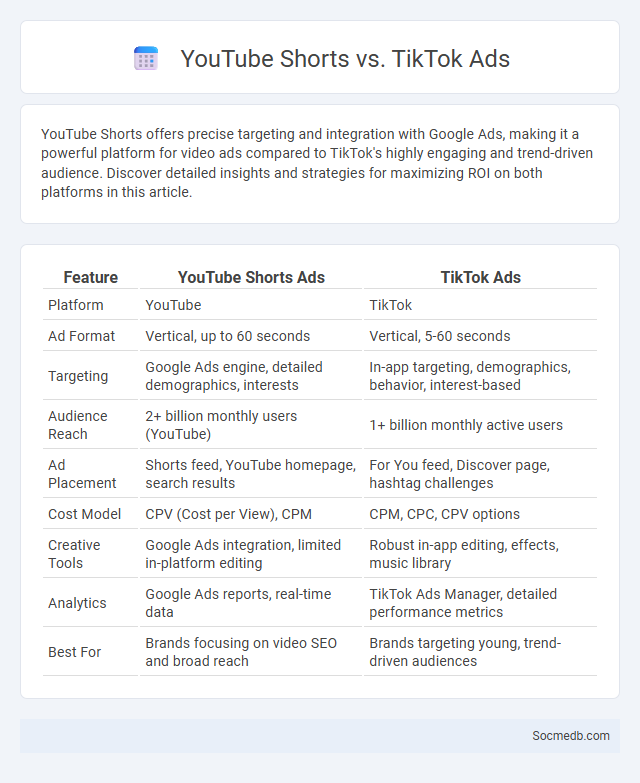
Photo illustration: YouTube Shorts vs TikTok Ads
YouTube Shorts offers precise targeting and integration with Google Ads, making it a powerful platform for video ads compared to TikTok's highly engaging and trend-driven audience. Discover detailed insights and strategies for maximizing ROI on both platforms in this article.
Table of Comparison
| Feature | YouTube Shorts Ads | TikTok Ads |
|---|---|---|
| Platform | YouTube | TikTok |
| Ad Format | Vertical, up to 60 seconds | Vertical, 5-60 seconds |
| Targeting | Google Ads engine, detailed demographics, interests | In-app targeting, demographics, behavior, interest-based |
| Audience Reach | 2+ billion monthly users (YouTube) | 1+ billion monthly active users |
| Ad Placement | Shorts feed, YouTube homepage, search results | For You feed, Discover page, hashtag challenges |
| Cost Model | CPV (Cost per View), CPM | CPM, CPC, CPV options |
| Creative Tools | Google Ads integration, limited in-platform editing | Robust in-app editing, effects, music library |
| Analytics | Google Ads reports, real-time data | TikTok Ads Manager, detailed performance metrics |
| Best For | Brands focusing on video SEO and broad reach | Brands targeting young, trend-driven audiences |
Overview: YouTube Shorts vs TikTok Ads vs Instagram Reels
YouTube Shorts, TikTok Ads, and Instagram Reels each offer unique advantages for social media marketing, targeting diverse audiences with short-form video content. TikTok Ads provide advanced targeting algorithms and viral potential, making it ideal for brands seeking rapid engagement and trend-driven campaigns. Instagram Reels integrates seamlessly with Instagram's ecosystem, allowing advertisers to leverage established follower bases, while YouTube Shorts benefits from YouTube's vast subscriber network and robust analytics for long-term audience growth.
Platform Popularity & User Demographics
TikTok dominates global social media platforms with over 1 billion monthly active users, particularly attracting Gen Z demographics aged 16-24 who engage with short-form video content. Instagram remains highly popular among Millennials and Gen X, boasting 2 billion users and strong engagement in lifestyle, fashion, and travel niches. Facebook continues to lead among older age groups (ages 35-65+), maintaining its position with 2.9 billion users by offering diverse features like groups, events, and marketplace functionality.
Content Formats and Creation Tools
Social media platforms offer diverse content formats, including images, videos, stories, reels, and live streams, each tailored to engage specific audience preferences. Popular creation tools like Canva, Adobe Spark, and Lumen5 enable users to design visually appealing graphics, edit videos, and produce interactive content that enhances brand visibility. Utilizing native platform features such as Instagram Reels, TikTok effects, and Facebook Live maximizes reach and fosters real-time engagement.
Advertising Options and Costs
Social media platforms offer diverse advertising options including sponsored posts, video ads, carousel ads, and story promotions, catering to varying business goals and audience targeting. Costs can range from as little as $0.50 per click on platforms like Facebook to $10 or more per 1,000 impressions on LinkedIn, depending on factors like competition, audience size, and ad quality. Maximizing your social media advertising budget requires selecting the right mix of ad formats and bidding strategies aligned with your campaign objectives.
Algorithm and Organic Reach
Social media algorithms prioritize content based on user engagement, relevance, and recency, which directly impacts your organic reach by filtering posts to show what is most likely to interest your audience. Understanding how platforms like Instagram, Facebook, and TikTok rank posts helps you optimize your content strategy to increase visibility without paid promotion. Consistently creating high-quality, engaging content encourages algorithm favorability, boosting your organic reach and enhancing audience connection.
Targeting Capabilities for Marketers
Social media platforms offer advanced targeting capabilities allowing marketers to reach specific audiences based on demographics, interests, behaviors, and location. By leveraging data analytics and machine learning algorithms, you can create highly personalized campaigns that increase engagement and conversion rates. These precise targeting options optimize ad spend and enhance overall marketing effectiveness.
Engagement Metrics and Performance Analytics
Engagement metrics such as likes, comments, shares, and click-through rates provide critical insights into audience interaction and content effectiveness on social media platforms. Performance analytics tools track these metrics over time, enabling marketers to identify trends, optimize posting schedules, and tailor content strategies for maximum reach and impact. Advanced analytics also measure sentiment, conversion rates, and follower growth, helping brands refine targeting and improve return on investment (ROI).
Monetization Opportunities for Creators
Social media platforms offer diverse monetization opportunities for creators, including ad revenue sharing, brand partnerships, and subscription-based content. Features such as YouTube's Partner Program, Instagram Shopping, and TikTok's Creator Fund enable influencers to generate income directly from their audience engagement. Leveraging these tools, creators can build sustainable revenue streams through sponsored posts, affiliate marketing, and paid memberships.
Brand Suitability and Industry Use Cases
Brand suitability on social media ensures content aligns with a company's values, protecting brand reputation across platforms like Facebook, Instagram, and LinkedIn. Industries such as retail, finance, and healthcare leverage brand suitability to target appropriate audiences and avoid risks associated with controversial content. Effective brand suitability strategies enhance advertising ROI by maintaining brand safety and fostering consumer trust.
Choosing the Right Platform for Your Marketing Strategy
Selecting the right social media platform is crucial for maximizing your marketing strategy's effectiveness. Analyze your target audience's demographics and behaviors to determine where they spend the most time, whether it's Instagram for younger users or LinkedIn for B2B connections. Tailoring your content to fit each platform's unique features increases engagement and boosts your overall brand presence.
 socmedb.com
socmedb.com